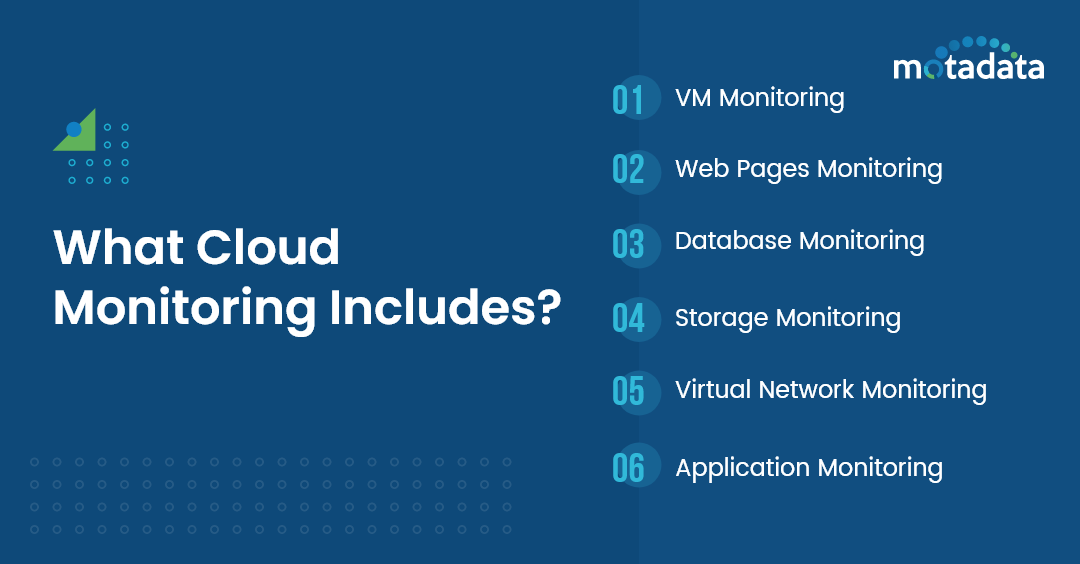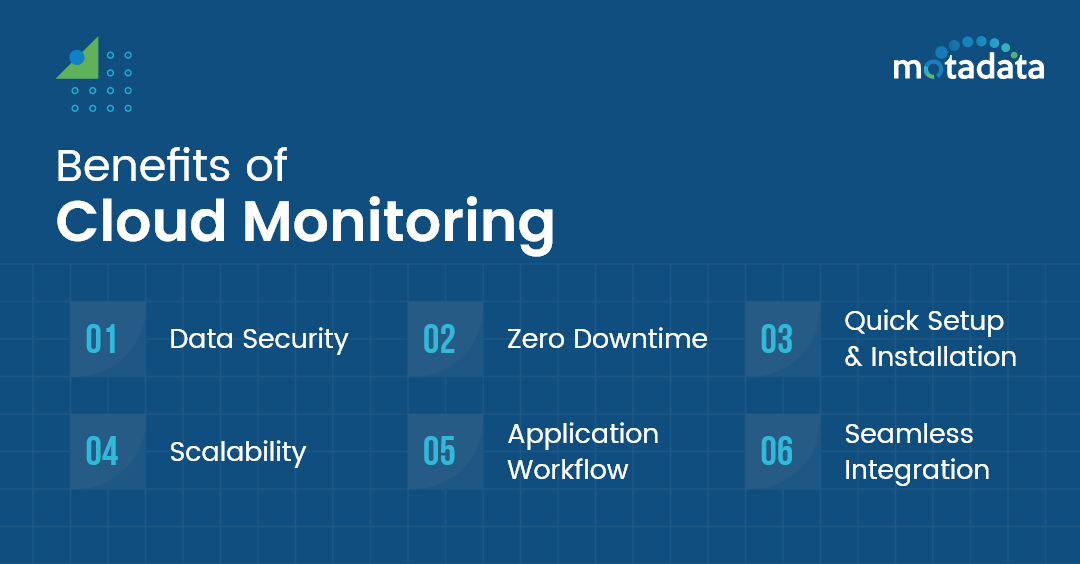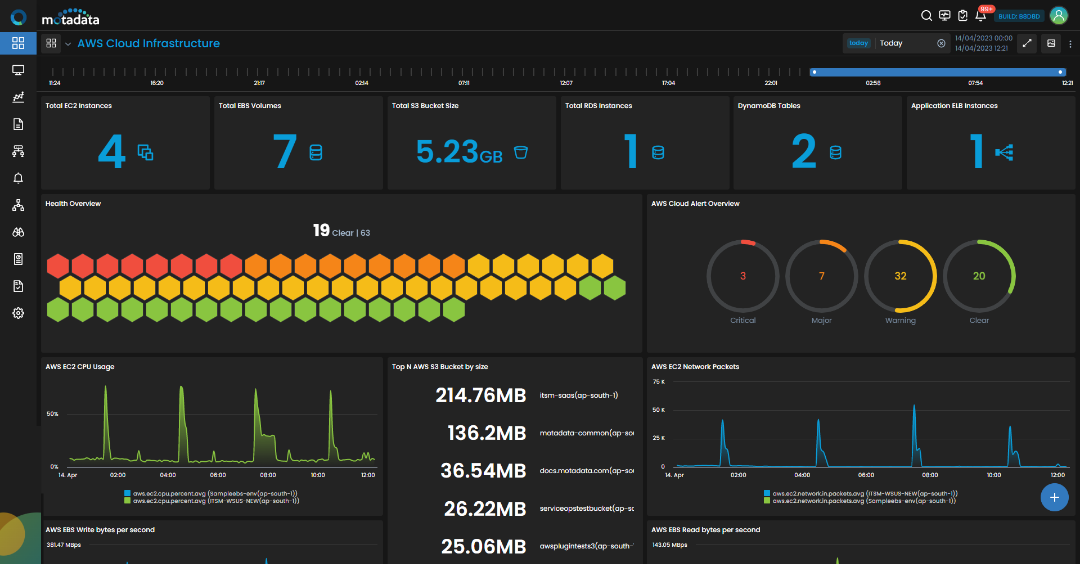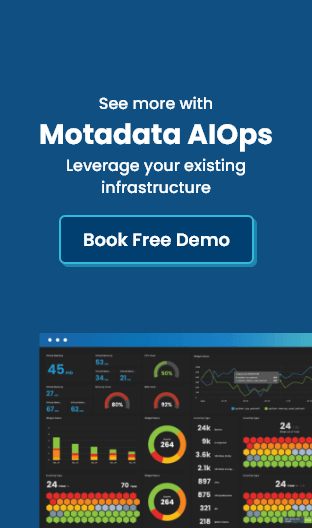Cloud monitoring can be a daunting task, just like designing the network involves a conscious plan of action to be in place.
In today’s hyper connected world everyone, literally everyone with an internet connection is accessing the cloud every day through one way or the other. And this holds true for all organizations; the cloud infrastructure has become an integral part of an organization’s operations and it is quite obvious that they need a cloud monitoring solution to monitor it.
Cloud provides unabridged business improvements in scalability & agility. Although with growth in cloud usage, comes an accelerated need to monitor network performance. That’s where cloud monitoring comes in.
Monitoring cloud infra helps a business to keep a close eye on reaction times, accessibility, asset utilization levels, execution, etc. just as troubleshooting issues.
Organizations can’t bear to have data breaches, downtime, or delayed response times and that’s where cloud monitoring comes in.
Smart cloud monitoring tools include prediction of potential issues, and help them to keep a track on the response times, resource consumption levels, performance and availability of cloud resources.
But before we delve deeper into each section, you must keep in mind that the big responsibility lies on cloud managers who need to leverage the right tools if they want to successfully monitor mission critical applications in the cloud environment.
What is Cloud Monitoring?
Cloud monitoring can be defined as the process of closely observing cloud-based applications and services. It’s the process of controlling and reviewing the operational workflow and processes within the cloud infrastructure.
This process involves use of manual as well as automated IT monitoring (with ITOM / NMS tools) and certain cloud infrastructure management techniques to make sure it performs optimally & efficiently.
Generally, admins have the authority to review the health and operational status of cloud servers and components.
Concerns emerge based on the kind of cloud structure the organization has, and how they utilize it. In case they are utilizing an open cloud infra, they will in general have limited control for managing the IT infra. A private cloud, which most organizations use, offers more control and adaptability, with included utilization benefits.
No matter what kind of cloud structure a company uses, monitoring is an important part of performance and security.
How Cloud Monitoring Works
The cloud has many aspects to it, and it’s essential to monitor it to guarantee everything works consistently for seamless operations. It essentially incorporates the following:
- Site checking: Tracking the procedures, traffic, accessibility and asset usage of cloud-facilitated sites
- Virtual machine checking: Monitoring the virtualization foundation and individual VMs
- Monitoring Databases: Monitoring forms, questions, accessibility, and utilization of cloud database assets like Azure
- Monitoring VMs: Monitoring virtual system assets, gadgets, associations, and VM execution
- Monitoring Distributed storage: Monitoring stockpiling assets and their procedures provisioned to VMs, administrations, databases, and applications.
What Cloud Monitoring Includes?
There are several elements that have to work in sync to optimize performance. Cloud monitoring primarily includes the following:
- VM Monitoring: Monitoring the virtual machines (instances) created on the cloud.
- Web Pages Monitoring: Monitoring the traffic, processes, resource utilization and availability of cloud-hosted websites.
- Database Monitoring: Monitoring different components of cloud database resources such as processes, queries, availability and consumption.
- Storage Monitoring: Monitoring storage resources on the cloud and tracking resource utilization.
- Virtual Network Monitoring: Tracking virtual network resources, connections, devices and performance.
- Application Monitoring: Proactively monitoring the availability & performance of critical applications deployed on the cloud whether it is on AWS or Microsoft Azure.
Cloud Monitoring Capabilities
Monitoring hybrid cloud infrastructure makes it simpler to distinguish different network architectures and pin-point potential IT security hazards. Some of the key cloud monitoring capabilities as are follows:
- Capacity to screen enormous volumes of cloud information crosswise over many appropriated areas
- Get visibility on the key metrics of the cloud application to prevent potential issues
- Consistent round the clock monitoring to guarantee new and changed documents are checked progressively
- Evaluating and revealing abilities to oversee IT security consistence
- Integration with cloud service providers like Amazon AWS etc.
What are the different offerings in cloud monitoring?
There are different types of cloud services that needs monitoring. It is not only about monitoring servers hosted on Google App Engine, Azure or AWS.
For enterprise customers it is all about monitoring what they consume (IT Infrastructure – Application, Database, OS, Server, Network etc.) and use in their daily operations bifurcated into what they manage and what the vendor manages.
What are the benefits of Cloud Monitoring?
Cloud monitoring tools are essential as they provide monitoring, management, reports and can even alert you to possible service disruptions.
Cloud monitoring helps in minimizing downtime and optimizing performance. Following are some of the ways to proactively manage the cloud and avoid frequent issues:
Data Security: For security it is important to attain strict control over data at all endpoints, thus minimizing risks. Quick fixes that analyze, scan and take action on data as it leaves the network help protect against data loss.
It’s also crucial to scan, evaluate and analyze incoming data to avoid malware and data breaches before it’s downloaded to the network.
APIs: The cloud can have multitude of performance issues due to poorly constructed APIs. Poor cloud API performance can be avoided by using APIs that work via objects instead of operations.
Eventually there’ll be fewer individual API calls and less traffic. APIs with few data type restrictions and logical design results in improved performance.
Application Workflow: Supporting resources and an application’s response time are important to understand what’s deteriorating the performance.
To pinpoint where and when delay occurs you need to follow an application’s workflow.
Tools that track consumption, performance and availability are required for monitoring the cloud while guaranteeing the secure transfer of data.
Just to summarize and highlights on the main benefits:
- No IT infrastructure required
- No CAPEX – only pay monthly subscription
- Quick Setup and Installation as infrastructure is already in place
- Scale as you need – can cater to organizations of different sizes
- Zero Downtime
- Quick Installation
- Unified Dashboard
- Open API for seamless integration
- Improved business efficiency
- Complete Visibility into Cloud Resources
- Monitor services and apps from any location having internet access
As per Gartner, I&O leaders should implement the following to cope up with the increased demand especially during the rapid digitalization that’s kicking in:
- Expanding workload capacity on-premise with the help of public cloud services
- With the help of cloud native architecture IT leaders can auto scale & build up capacity for surged demand
- Real time performance monitoring to ensure the continuity of business operations
- On-premise data centers may not be able to handle the surge in demand, moving to cloud is a smart move
- Leveraging multi-cloud tools to prevent resource shortfalls in specific areas.
What are the features of Cloud Monitoring?
Cloud monitoring makes it simple to analyses patterns and detect potential security risks in the cloud infrastructure.
Following are some of the key capabilities:
- Investigating and reporting capabilities for security compliance
- Uninterrupted monitoring to ensure recent and modified files are examined in real time
- Accommodating an array of cloud service providers
- Large volumes of cloud data across various distributed locations can be monitored
- Potential attacks or compromises can be identified by enabling visibility into user, application and file behavior.
Monitoring Private, Public, and Hybrid Clouds
- Cloud monitoring is straightforward if you engage in a private cloud for a few reasons we mentioned earlier (visibility and control), as you have connection to the software stack and systems.
- Nevertheless, monitoring can be further problematic in public or hybrid clouds.
- A hybrid cloud setting presents uncommon challenges because data consists in both the public and private cloud. Constraints regarding compliance and security can create problems for data accessing users.
- Admins can clarify performance issues by identifying in which cloud the data has to be stored in addition to what data to update.
- Synchronization of data can be a roadblock as well, but segregating data into faster and smaller parts helps in diminishing issues.
Even though private cloud grants more control, to ensure optimum performance one still need to monitor workloads.
If you don’t have a clear view of workload and network performance, then you won’t be able to justify architectural or configuration changes, for a better quality of service implementations or other technologies.
Best Practices for Cloud Monitoring
Guaranteeing enhanced execution and limiting IT downtime for cloud assets is essential. Here are some of the most effective ways to proactively deal with the cloud environment and maintain a strategic distance from repetitive issues:
IT Security: IT Security is pivotal in the cloud so overseeing information at all endpoints mitigates dangers. Arrangements that filter, break down, and make a move on information before it leaves the system help ensure there is no lost information.
It’s additionally critical to filter, assess, and group information before it’s downloaded to the system to stay away from malware and information break-downs.
APIs: The cloud can have a variety of execution issues from ineffectively planned APIs. You can maintain a strategic distance from poor cloud API execution by utilizing APIs that work by means of IT Ops.
This results in lowering the API calls which implies low traffic. APIs with steady plans and lower limitations on its data type bring about better execution of processes.
Application Workflow: An application’s reaction time and supporting assets are crucial in understanding what’s obstructing optimal execution of operations on Cloud.
Following an application’s work process, encourages you to recognize where & when deferrals happen.
Distributing Cloud Servers & Storage: Overprovisioning cloud services—gobbles up IT assets, their accessibility and can block execution of processes.
ITOM software can enable you to discover the issues, at that point using appropriate strategies and methods.
Cloud monitoring requires tools that track its execution, track resource utilization, and their accessibility while guaranteeing the safe exchange of information in between them.
This empowers organizations to discover a harmony by moderating dangers while utilizing the advantages of the cloud.
What are Motadata key solution highlights that help to monitor, manage and control resources of a cloud environment?
IT monitoring software (ITOM) like Motadata are useful for cloud monitoring, as they can follow executions, report results, and caution you to conceivable administration disturbances.
The software can help users monitor, analyze, optimize and then resolve detected issues at any layer of cloud environment from the base right up to the end-user experience and provide the best possible visibility on cloud assets.
Motadata monitors Amazon AWS, Microsoft Azure, Google App Engine, and hybrid cloud environments.
Motadata’s cloud monitoring platform which is a part of ITOM software also known as Infrastructure Intelligence Platform (IIP) monitors metrics such as the availability, response time, and frequency of usage of cloud assets, etc.
AWS AIX: Get improved visibility with AWS monitoring. Monitor the performance of AWS hosted applications. Drill down into each and every transaction, extract critical code level details to resolve performance issues for your distributed AWS applications.
Google App Engine: Motadata provides unabridged Google App Engine monitoring capabilities which allow you to effectively and quickly monitor your cloud based resources along with your on-premise networks.
Microsoft Azure: Monitor Microsoft Azure workloads and analyses the utilization of resources and overall cloud infrastructure health, by analyzing critical KPIs like CPU, storage, memory, and resource usage.
Through this blog we did understand that Cloud Monitoring has become an indispensable part of businesses and hence effective monitoring is important.
An ideal cloud monitoring solution optimizes organizations cloud infrastructure through various parameters and metrics to ensure the desired level of outcome is achieved.
This is where a monitoring solution such as Motadata Cloud, provides a single view of IT infrastructure – network, applications, database, server to help you solve your most complex performance and reliability problems quickly, simply & affordably.
If you want to gain complete visibility into your cloud resources with a powerful extensive cloud monitoring solution reports, unlocked by the Network Monitoring Platform’s Cloud Monitoring Module, sign up for the free trial today!






